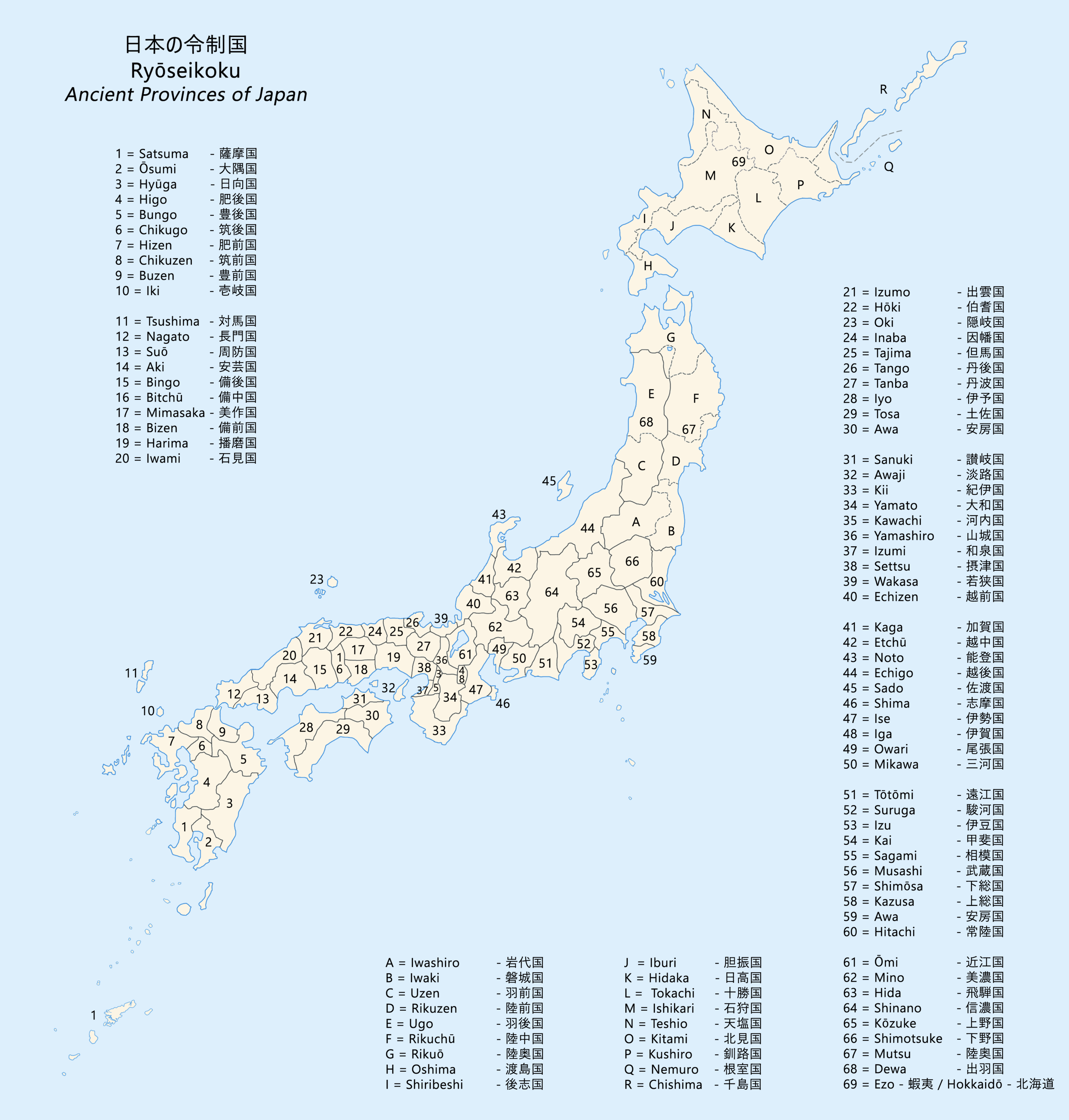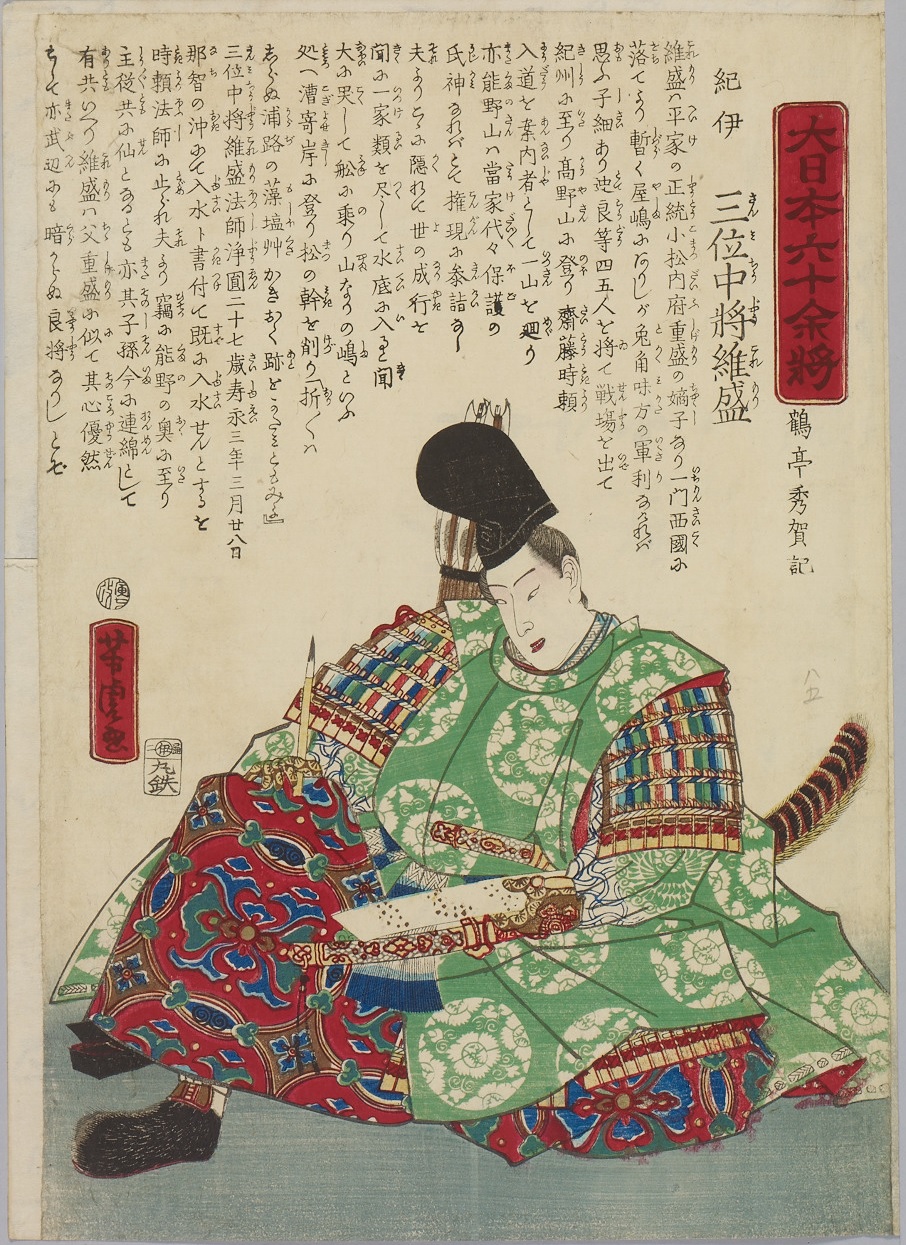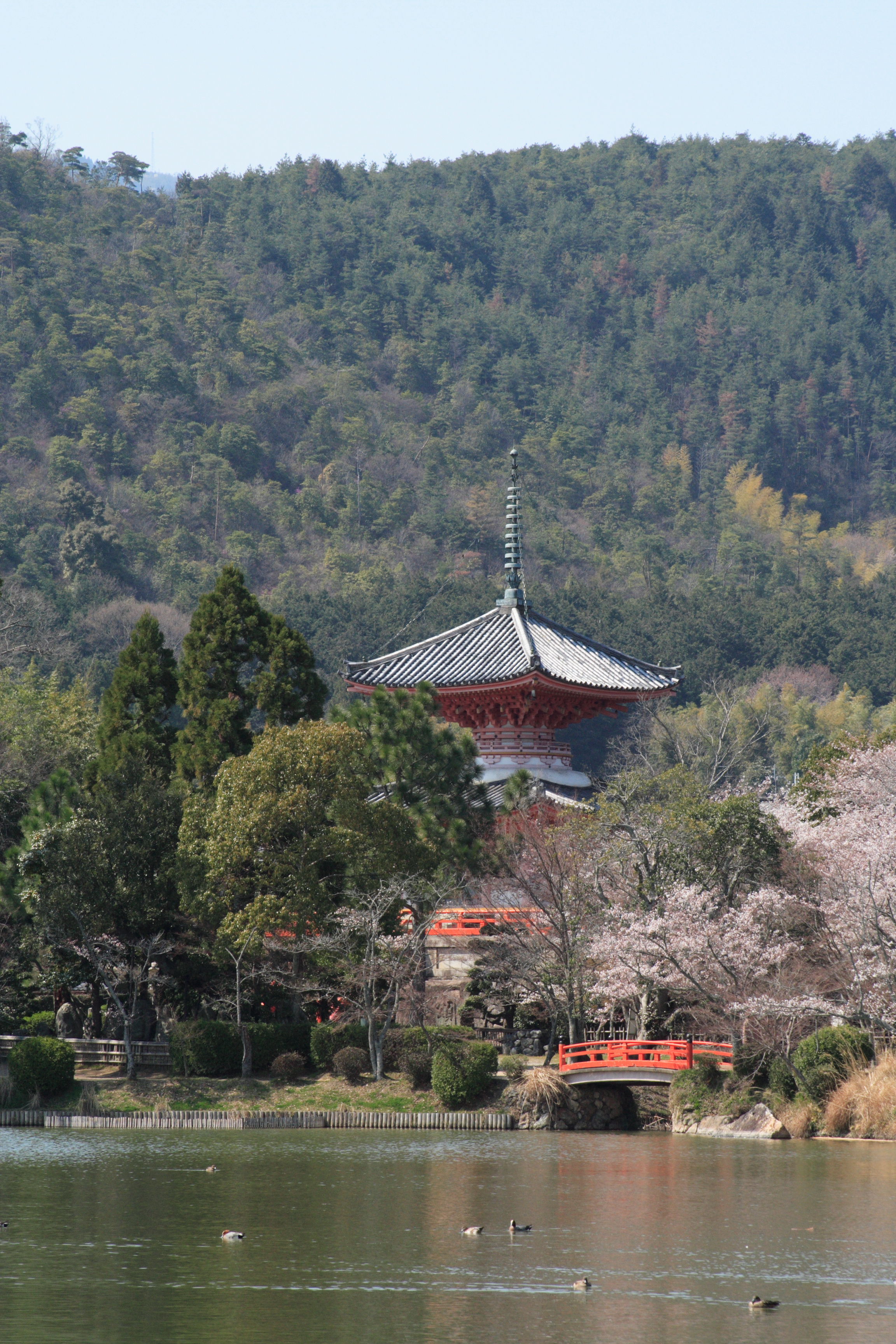|
Taira No Takakiyo
{{family name hatnote, Taira, lang=Japanese Taira no Takakiyo (平高清/ Taira no Rokudai 平六代, 1173 – March 3, 1199) was a member of the ruling Taira clan from the late Heian period to the early Kamakura period. He was the son of Taira no Koremori and brother of Taira no Chikazane. Life He was given the childhood name, “Rokudai” (meaning sixth generation in Japanese), as he was the sixth direct descendant of Taira no Masamori. He was also referred to as Rokudaimaru. His real name was Takakiyo, as recorded in the Koya Shunjuu Henen Shuuroku, a written historical chronicle of Koya Mountain. However, “The Tale of Heike” referred to him as Rokudai, thus he is generally referred to as such. In 1183, the Taira clan had made the decision to flee the Kyoto before the Minamoto no Yoshinaka led attack on the capital. Rokudai's mother (Taira no Koremori's wife), who was very much comfortable in the capital, could not tolerate the thought of leaving the capital and escapin ... [...More Info...] [...Related Items...] OR: [Wikipedia] [Google] [Baidu] |
Taira Clan
The Taira was one of the four most important clans that dominated Japanese politics during the Heian, Kamakura and Muromachi Periods of Japanese history – the others being the Fujiwara, the Tachibana, and the Minamoto. The clan is divided into four major groups, named after the emperor they descended from: Kanmu Heishi, Ninmyō Heishi, Montoku Heishi, and Kōkō Heishi. The clan is commonly referred to as or , using the character's On'yomi for ''Taira'', while means " clan", and is used as a suffix for " extended family". History Along with the Minamoto, Taira was one of the honorary surnames given by the emperors of the Heian Period (794–1185 CE) to their children and grandchildren who were not considered eligible for the throne. The clan was founded when the Imperial Court grew too large, and the emperor ordered that the descendants of previous emperors from several generations ago would no longer be princes, but would instead be given noble surnames a ... [...More Info...] [...Related Items...] OR: [Wikipedia] [Google] [Baidu] |
Heian Period
The is the last division of classical Japanese history, running from 794 to 1185. It followed the Nara period, beginning when the 50th emperor, Emperor Kanmu, moved the capital of Japan to Heian-kyō (modern Kyoto). means "peace" in Japanese. It is a period in Japanese history when the Chinese influences were in decline and the national culture matured. The Heian period is also considered the peak of the Japanese imperial court and noted for its art, especially poetry and literature. Two types of Japanese script emerged, including katakana, a phonetic script which was abbreviated into hiragana, a cursive alphabet with a unique writing method distinctive to Japan. This gave rise to Japan's famous vernacular literature, with many of its texts written by court women who were not as educated in Chinese compared to their male counterparts. Although the Imperial House of Japan had power on the surface, the real power was in the hands of the Fujiwara clan, a powerful aristocr ... [...More Info...] [...Related Items...] OR: [Wikipedia] [Google] [Baidu] |
Kamakura Period
The is a period of Japanese history that marks the governance by the Kamakura shogunate, officially established in 1192 in Kamakura by the first '' shōgun'' Minamoto no Yoritomo after the conclusion of the Genpei War, which saw the struggle between the Taira and Minamoto clans. The period is known for the emergence of the samurai, the warrior caste, and for the establishment of feudalism in Japan. During the early Kamakura period, the shogunate continued warfare against the Northern Fujiwara which was only defeated in 1189. Then, the authority to the Kamakura rulers waned in the 1190s and power was transferred to the powerful Hōjō clan in the early 13th century with the head of the clan as regent ( Shikken) under the shogun which became a powerless figurehead. The later Kamakura period saw the invasions of the Mongols in 1274 and again in 1281. To reduce the amount of chaos, the Hōjō rulers decided to decentralize power by allowing two imperial lines – Northern and Sout ... [...More Info...] [...Related Items...] OR: [Wikipedia] [Google] [Baidu] |
Taira No Koremori
(1158 – 1184) was one of the Taira clan's commanders during the Genpei War of the late Heian period of Japanese history. He was the eldest son of Taira no Shigemori, who was the eldest regent and heir of Taira no Kiyomori. Early life Taira no Koremori was born in 1158. In contrast to his father, who was a warrior focused on battle, he grew up to be a young nobleman who enjoyed poetry and music. Genpei War During the Genpei War, Koremori lost the Battle of Fujikawa in 1180. He invaded three years later Echizen Province, taking Hiuchiyama and several other of Minamoto no Yoshinaka's strongholds. However, Yoshinaka was able to take back the strongholds and defeat Koremori during the Battle of Kurikara. Koremori fled the Heike headquarters during the Battle of Yashima, and sought to reunite with his family left behind in the capital. However, along the way back he met the priest Takiguchi, formerly Saito Tokiyori, on Mount Kōya and became a monk. The rumor later spread t ... [...More Info...] [...Related Items...] OR: [Wikipedia] [Google] [Baidu] |
Taira No Chikazane
(1178-1225) was the last living member of the Taira clan. He was the son of Taira no Koremori, grandson of Taira no Shigemori, and great-grandson of Taira no Kiyomori. He and his brother, Taira no Takakiyo, were the only male members of the Taira clan to survive the Genpei War. His brother was executed in 1199, but Chikazane lived until 1225. His death marked the end of the Taira clan. Oda Nobunaga was a Japanese '' daimyō'' and one of the leading figures of the Sengoku period. He is regarded as the first "Great Unifier" of Japan. Nobunaga was head of the very powerful Oda clan, and launched a war against other ''daimyō'' to unif ... claimed descent from him. ReferencesUtagawa Kunisada (Toyokuni III) - series and prints Horst Graebner, Society for Japanese Arts. Accessed March 11, 2008. {{DEFAULTSORT:Taira no, Chikazane Daimyo Taira clan ... [...More Info...] [...Related Items...] OR: [Wikipedia] [Google] [Baidu] |
Wakayama Prefecture
is a prefecture of Japan located in the Kansai region of Honshu. Wakayama Prefecture has a population of 944,320 () and has a geographic area of . Wakayama Prefecture borders Osaka Prefecture to the north, and Mie Prefecture and Nara Prefecture to the northeast. Wakayama is the capital and largest city of Wakayama Prefecture, with other major cities including Tanabe, Hashimoto, and Kinokawa. Wakayama Prefecture is located on the western coast of the Kii Peninsula on the Kii Channel, connecting the Pacific Ocean and Seto Inland Sea, across from Tokushima Prefecture on the island of Shikoku. History Present-day Wakayama is mostly the western part of the province of Kii. 1953 flood disaster On July 17–18, 1953, a torrential heavy rain occurred, followed by collapse of levees, river flooding and landslides in a wide area. Many bridges and houses were destroyed. According to an officially confirmed report by the Government of Japan, 1,015 people died, with 5,709 inj ... [...More Info...] [...Related Items...] OR: [Wikipedia] [Google] [Baidu] |
Daikakuji
is a Shingon Buddhist temple in Ukyō-ku, a western ward in the city of Kyoto, Japan. The site was originally a residence of Emperor Saga (785–842 CE), and later various emperors conducted their cloistered rule from here. The ''Saga Go-ryū'' school of ikebana has its headquarters in the temple. The artificial lake of the temple, Ōsawa Pond, is one of the oldest Japanese garden ponds to survive from the Heian period. History The origins of the temple dates back to the Heian period in the year 814 CE, when Emperor Saga had a palace, known as the ''Saga-in'', constructed on the site. The palace later became his seat of retirement, known as ''Saga Rikyu'' imperial villa. According to tradition, when Japan suffered a serious epidemic, the Buddhist monk Kobo Daishi, the founder of Shingon Buddhism, suggested that the Emperor Saga personally copy an important Buddhist religious document called the Heart Sutra (''Hannya Shingyō''). The emperor made a handwritten copy, and ... [...More Info...] [...Related Items...] OR: [Wikipedia] [Google] [Baidu] |
Kamakura
is a city in Kanagawa Prefecture, Japan. Kamakura has an estimated population of 172,929 (1 September 2020) and a population density of 4,359 persons per km² over the total area of . Kamakura was designated as a city on 3 November 1939. Kamakura was the ''de facto'' capital of Japan from 1185 to 1333 as the seat of the Kamakura Shogunate, and became the nation's most populous settlement during the Kamakura period. Kamakura is a popular domestic tourist destination in Japan as a coastal city with a high number of seasonal festivals, as well as ancient Buddhist and Shinto shrines and temples. Geography Surrounded to the north, east, and west by hills and to the south by the open water of Sagami Bay, Kamakura is a natural fortress. Before the construction of several tunnels and modern roads that now connect it to Fujisawa, Ofuna ( ja) and Zushi, on land it could be entered only through narrow artificial passes, among which the seven most important were called , a name so ... [...More Info...] [...Related Items...] OR: [Wikipedia] [Google] [Baidu] |
Mongaku
Mongaku (文覚) was a Japanese samurai and Shingon Buddhist priest of the late Heian and early Kamakura period. He was a close associate of shogun Minamoto no Yoritomo, having contributed to the declaration of the Genpei War. Myōe was the disciple of his disciple Jōkaku. His secular name, before ordination, was Endō Moritō. He is also known as Mongaku Shōnin. Life Mongaku was born the son of Endō Mochitō, a samurai in the Watanabe faction of the Settsu Genji clan (a branch of the Minamoto clan). He initially served in the Imperial Palace Guards of the North Side. He fell in love with Kesa, the wife of Minamoto no Wataru, but killed her by accident. Out of repentance, he then ordinated as a priest, visiting sacred places across the country. Mongaku moved to live at Jingo-ji temple in 1168, and participated in its restoration work motivated by his reverence towards Kūkai. In 1173, he requested a manorial temple estate for Jingo-ji from Cloistered Emperor Go-Shiraka ... [...More Info...] [...Related Items...] OR: [Wikipedia] [Google] [Baidu] |
Minamoto No Yoritomo
was the founder and the first shogun of the Kamakura shogunate of Japan, ruling from 1192 until 1199.Nussbaum, Louis-Frédéric. (2005). "Minamoto no Yoriie" in . He was the husband of Hōjō Masako who acted as regent ('' shikken'') after his death. Yoritomo was the son of Minamoto no Yoshitomo and belonged to Seiwa Genji's prestigious Kawachi Genji family. After setting himself the rightful heir of the Minamoto clan, he led his clan against the Taira clan from his capital in Kamakura, beginning the Genpei War in 1180. After five years of war, he finally defeated the Taira clan in the Battle of Dan-no-ura in 1185. Yoritomo thus established the supremacy of the warrior samurai caste and the first shogunate ('' bakufu'') at Kamakura, beginning the feudal age in Japan, which lasted until the mid-19th century. Early life Yoritomo was the third son of Minamoto no Yoshitomo, heir of the Minamoto ( Seiwa Genji) clan, and his official wife, Yura-Gozen, daughter of Fujiw ... [...More Info...] [...Related Items...] OR: [Wikipedia] [Google] [Baidu] |
Oki Province
was a province of Japan consisted of the Oki Islands in the Sea of Japan, located off the coast of the provinces of Izumo and Hōki. The area is now Oki District in modern Shimane Prefecture. Nussbaum, Louis-Frédéric. (2005). "''Awa no Kuni''" in . Its abbreviated form name was , Oki is classified as one of the provinces of the San'indō. Under the ''Engishiki'' classification system, Oki was ranked as an "inferior country" (下国) and a "far country" (遠国). History The Oki Islands have been settled since the Japanese Paleolithic period, and numerous remains from the Jōmon, Yayoi and Kofun periods indicates continuous human occupation and activity. It was organized as a province under the Ritsuryō reforms in the later half of the seventh century, and the name "Oki-no-kuni" appears on wooden markers found in the imperial capital of Nara. During the late Heian period, due to its remoteness, Oki Province came to known as a place for political exile. In 1221, Emperor ... [...More Info...] [...Related Items...] OR: [Wikipedia] [Google] [Baidu] |
Minamoto No Yoriie
was the second ''shōgun'' (1202–1203) of Japan's Kamakura shogunate, and the first son of first shōgun Yoritomo. His Dharma name was Hokke-in-dono Kingo Da'i Zengo (法華院殿金吾大禅閤). Life Minamoto no Yoriie was born to Hōjō Masako at Hiki Yoshikazu's residence in Kamakura.Yasuda (1990:592-593) Before he was born, his father Yoritomo had Hōjō Tokimasa and his men carry stones to build the Dankazura on Wakamiya Ōji to pray for the child's safe delivery. When Yoriie later himself had an heir, Ichiman, the child was also born at the Hiki mansionThe mansion no longer exists and its location () is occupied by Myōhon-ji a temple dedicated to the memory of the Hiki clan, exterminated by the Hōjō clan. to Hiki's daughter Wakasa no Tsubone, a fact which further consolidated an already strong emotional bond.Kamiya Vol. 1 (2008:44-45) From this relationship Hiki gained considerable influence when Yoriie became shōgun, incurring the hostility of Hōjō Toki ... [...More Info...] [...Related Items...] OR: [Wikipedia] [Google] [Baidu] |





